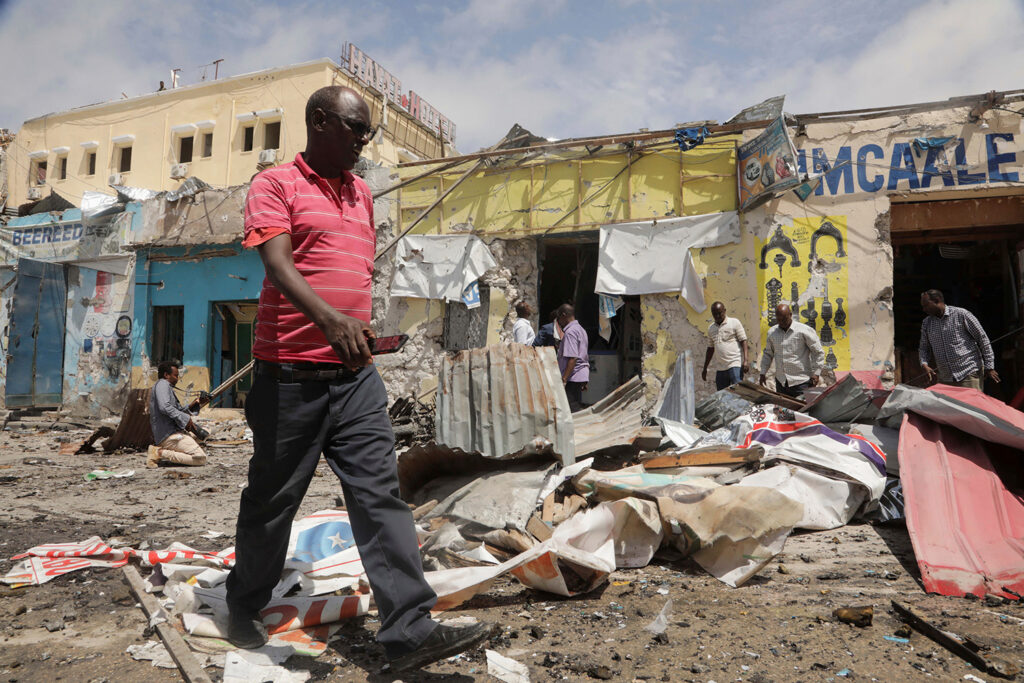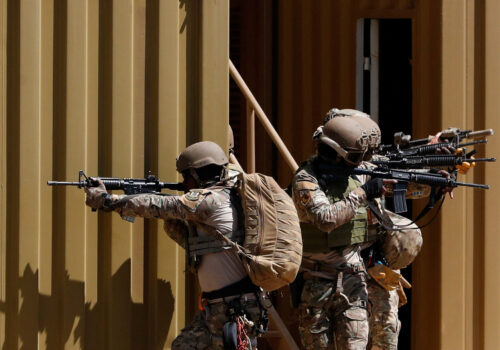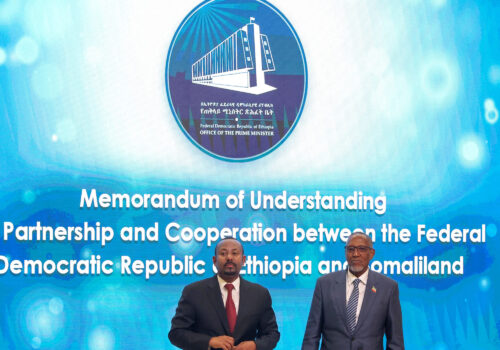Amid a deepening security crisis, the Trump administration is reportedly considering whether to reduce the US footprint in Somalia, for example by closing the US embassy in Mogadishu. This potential reversal comes even as the United States continues to carry out airstrikes against Somali militants.
Islamist insurgents, including al-Shabaab and the Somali affiliate of the Islamic State of Iraq and al-Sham (ISIS-S), are making territorial gains. These two groups represent distinct but overlapping threats—each transnational, each integrated into broader jihadist ecosystems, and each capable of destabilizing regional and global security if left unchecked. They are also quickly evolving, including by increasing connections with other groups and malign state actors such as the Islamic Republic of Iran—creating larger geostrategic implications.
To address this evolution, the United States must remain engaged in Somalia; but that does not necessarily require escalation. Strategic engagement through a forward embassy, regional partnerships, and calibrated intelligence operations can disrupt the evolution of the terrorist threat in Somalia—and it costs far less than what it would take to contain fully metastasized, adaptive adversaries down the road.
Increasingly adaptive
For too long, ISIS-S has been treated as an afterthought in Somalia’s counterterrorism landscape, but the group can no longer be ignored: Since 2019, it has evolved significantly, becoming the Islamic State’s most agile, digitally integrated, and externally operational franchise. This has aligned with the Islamic State’s global shift toward a decentralized, node-based network managed by the General Directorate of Provinces. Formerly a localized insurgency attempting to replicate elements of the core caliphate in miniature, ISIS-S is now modular, externally focused, and nonterritorial, with unique technical capabilities that elevate its threat beyond that of traditional insurgent groups.
It does not seek to hold Mogadishu; rather, ISIS-S bypasses the Somalian capital to exploit ungoverned spaces through coordinated disruption. Its efforts destabilize governance; it coordinates its operations via encrypted messaging apps, blockchain-based payment systems, commercial off-the-shelf obfuscation tools, and artificial intelligence-generated multilingual propaganda that enables large-scale recruitment.
The ISIS-S threat is transnational and no longer confined to Somalia; that is apparent with the group’s implication in terror plots overseas, including in Sweden. Perhaps most critically for the United States, the ISIS-S al-Karrar office is understood to serve as a funding node for ISIS-Khorasan, which has proven capable of devastating terror plots, including the 2021 Abbey Gate bombing in Afghanistan that killed thirteen US service members.
Al-Shabaab, al-Qaeda’s East African affiliate, has also proven to be far more than a local insurgency—it is a deeply entrenched and militarily assertive force in Somalia, capable of executing complex operations, controlling territory, and challenging both national and international security efforts. This transnational terrorist organization has already exerted influence beyond Somalia, having executed mass-casualty attacks in Kenya and Uganda. In 2020, its operatives struck US and Kenyan forces in Manda Bay, killing three Americans. The group explicitly targets US and Western interests throughout East Africa. Withdrawing now, as al-Shabaab regains momentum, risks allowing it to strengthen its position and expand its influence.
Metastizing menace
Of parallel concern is the mounting evidence of cooperation between al-Shabaab and the Iran-backed Houthis in Yemen. This partnership represents a dangerous escalation. The Houthis have repeatedly demonstrated the ability to strike maritime targets in the Red Sea and the Gulf of Aden using anti-ship missiles, drones, and explosive-laden boats. These asymmetric maritime attacks have disrupted vital shipping lanes, endangered commercial vessels, and necessitated multinational naval responses. They also offer a template for al-Shabaab’s future posture.
Growing evidence exists that Houthi weaponry, supplied by Iran, has been transferred into Somalia and reached both al-Shabaab and ISIS-S. These transfers suggest an intensifying convergence of interests but not ideologies. While al-Shabaab, ISIS-S, and the Houthis remain doctrinally divergent, they share three critical traits: a reliance on illicit maritime logistics, the use of asymmetric tactics, and a willingness to cooperate when it serves operational goals. This alignment adds complexity to counterterrorism efforts in the Horn of Africa, blurring the lines between ideological enemies and functional partners.
The Bab el-Mandeb Strait, just north of Somalia, is a critical chokepoint for global trade, funneling approximately 12 percent of seaborne oil trade flows. Increased attacks or insecurity in these waters would drive up insurance costs, increase shipping expenses, and worsen instability across East Africa and the Middle East. Should al-Shabaab or ISIS-S, either independently or in partnership with the Houthis, begin to harass this artery, it would have immediate implications for the global economy.
But in addition to the potential economic impact, there is also a clear strategic threat from this cooperation. Hostility to the West and asymmetrical warfare exercised by these groups and the militias included in Iran’s Axis of Resistance could pose an enduring threat to US allies and partners in the region. For example, the US Navy could see its operational freedom eroded, and militant activity in the sea lanes around the Horn of Africa—which connect the Mediterranean to the Indo-Pacific—could complicate the United States’ ability to surge naval forces in response to crises involving China in the Taiwan Strait or Russia in the eastern Mediterranean.
Continuity as containment
The 2021 US withdrawal from Somalia offered a preview of what disengagement would yield. Following the withdrawal, al-Shabaab and ISIS-S regrouped, expanded their respective operations, and forged deeper regional ties that present the greater challenges that the United States faces today. Although US forces returned in 2022, the withdrawal had already proved costly.
Today, ISIS-S internally exploits the geography of Somalia, clan connections, and instability to thrive. Al-Shabaab forces inch ever forward in their ongoing campaign to isolate and potentially capture the capital of Mogadishu. Each debate over whether to stay or go provides strategic space that the groups use to adapt.
The post-9/11 experience has demonstrated that power vacuums can be quickly filled by hostile actors. The 2011 withdrawal from Iraq enabled ISIS’s rapid rise. Strategic ambiguity in Libya yielded terrain for jihadist experimentation. Afghanistan’s rapid collapse under the Taliban offered ISIS-Khorasan and al-Qaeda a second wind. Somalia is not an exception: It would be the next domino.
But it’s not just a matter of being present. For example, the 2012 Benghazi attack was not a failure of presence; it was a failure of planning, coordination, and establishing an adequate security posture. Similarly, abandoning Somalia without a coherent containment strategy creates the risk of empowering a transnational terrorist organization with international ambitions while simultaneously allowing Iran to extend its strategic reach.
To maintain its foothold at the most critical junction of East Africa’s security architecture, the United States must prioritize continuity. This includes keeping the US embassy in Mogadishu open, as it provides a platform for intelligence coordination, interagency operations, and diplomatic leverage. Without it, the United States cannot assess—let alone contain—a threat that is actively recombining in real time and posing risks to maritime security, the regional balance of deterrence, and potentially the US homeland.
The terrorist groups based in Somalia are adapting faster, making broader connections, and integrating deeper than Washington’s withdrawal advocates seem to realize. To misread that evolution as localized or static is strategic negligence. A decision to withdraw at this moment will not be remembered as a tactical recalibration but as an unforced error. To leave is to license the evolution of these terrorist groups; to stay is to disrupt it.
Danielle Cosgrove is a senior advisor to the Atlantic Council’s Counterterrorism Group. She is a distinguished guest lecturer at Stanford University, a Stanford Medicine X scholar, and the founder of an acquired threat mapping startup.
Doug Livermore is a member of the Atlantic Council’s Counterterrorism Group, the national vice president for the Special Operations Association of America, and the deputy commander for Special Operations Detachment–Joint Special Operations Command in the North Carolina Army National Guard.
Disclaimer: The views expressed are the authors’ and do not represent official US government positions.
Further reading
Thu, Mar 13, 2025
What airstrikes in Somalia show about the war on terror
AfricaSource By Alexander Tripp
With terrorist groups increasingly prevalent throughout Africa, the United States is likely to devote more attention to counterterrorism efforts on the continent.
Thu, Jan 2, 2025
Experts react: What the New Orleans attack tells us about terrorism in 2025
New Atlanticist By
The attack on New Year’s Day by a man who claimed to have joined ISIS raises important questions about safety and security.
Thu, Feb 22, 2024
What the Ethiopia-Somaliland deal means for Washington’s strategy in the Red Sea
AfricaSource By
Developments around the deal could bring simmering conflicts to a boil—or they could potentially advance peace and prosperity in the region.
Image: Residents look at the scene of an al Qaeda-linked al-Shabaab group militant attack in Mogadishu, Somalia on August 21, 2022. Photo via REUTERS/Feisal Omar.




